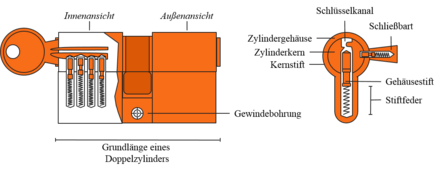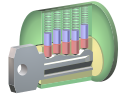Lock cylinder
A lock cylinder is the part of the cylinder lock that can be operated by means of a key and usually consists of a housing and a rotatable cylinder core. There are various designs such as profile cylinders , round cylinders , oval cylinders and the like. v. a. Half cylinders can only be closed from one side, double cylinders from both; Knob cylinders can be operated on one side with a key and on the other with a permanently mounted rotating knob .
history
As early as January 29, 1861, the American Linus Yale applied for a patent for a round cylinder lock with four pin tumblers under No. 31278 , and on June 27, 1865 his patent 48475 for a round cylinder with five tumblers followed.
On October 25, 1928, the Reich Patent Office granted the patent for the profile cylinder with document no. 468260. The profile cylinder was developed in 1924 by Sylvester Wöhrle, engineer at the " Zeiss Ikon " subsidiary Hahn AG for optics and mechanics.
The locking cylinders are standardized in DIN EN 1303 "Lock cylinders for locks" and DIN 18252 "Profile cylinders for door locks".
functionality
Nowadays, the lock cylinder is the core of the security of lock and door. The key has mechanical (now also electronic) codes in the form of incisions (and / or drill hollows) and its profile.
These codes are scanned in the lock cylinder. If the profile of the key and the profile of the lock cylinder match, the key can be inserted. If the notches in the key also fit, the pins in the lock cylinder are arranged so that the core can be turned - it is unlocked.
Break-in security
Lock cylinders must be protected against breaking, drilling open, pulling out and other attacks. Lock cylinders with anti-drilling protection , core extraction lock and extraction protection offer a high degree of resistance to these overcoming methods .
By installing a burglar-resistant door plate or fitting with integrated pulling protection, a lock cylinder can also be protected against these attack methods.
safety
The security of profile cylinders is not even close to being decisive for a safe home. This is often mistakenly assumed. In order to secure a door (regardless of whether it is an apartment or house door) as best as possible, you first need a stable door itself (this can be easily recognized in the case of wooden doors in apartments by the weight of the door). The door's strike plate should be robust and anchored in the brickwork. The mortise lock used should, if possible, be made of metal (especially the internal mechanism and latch) and not plastic and, if possible, offer a protective function that blocks the mortise lock mechanism if the mortise lock is damaged, for example by drilling. This additional protection is very rare with mortise locks, but it makes sense. The top priority, however, is what is known as a core pulling protection fitting, which tries to prevent the cylinder from cracking or pulling out the cylinder core. In order to find a “perfect” profile cylinder, you have to make a compromise between forcible opening, copy protection and non-destructive opening, for better or worse. In fact, good copy protection of the keys can only be found in expensive systems; keys with a movable element are extremely difficult to copy (almost impossible). Unfortunately, this type of lock does not necessarily offer maximum security in terms of non-destructive opening by lock picking . The search for a cylinder that is as secure as possible with regard to destructive opening leads to locks that offer exactly these properties, but then in turn have to prescribe prints for non-destructive opening and copy protection. There are currently only two really popular and commercially available systems that cover all three safety aspects as best as possible, based on the technology of magnetic rotors.
Unlocking security
Unlocking is the resistance that a lock cylinder offers against attempts to open it with locking tools . Every attempt to overcome locking cylinders by opening a number of technical precautions, such as. B. dumbbell pins , paracentric key profiles and additional locking elements opposite. So far, a pulling protection device using a cross pin has always been effective. During assembly, the door signs or fittings should be dismantled, then the lock should be installed. The fittings are then reassembled and screwed on from the inside. There is then the best possible pulling protection, since the door plate holds the lock particularly well. The pioneer is the company Keso from Switzerland, which means that other suppliers have followed suit.
Mechatronic locking cylinders, in which a battery and electronics are in the "mechanical" key, are a very new development . The key has an electrical connection to the lock and a code is transmitted to release the lock.
Emergency and hazard function
Conventional lock cylinders cannot be turned if a key is in the turned position on the other side. Therefore, special locking cylinders are offered under terms such as "with emergency and danger function ", "with danger device" or "lockable on both sides", which both prevent unintentional locking and ensure that the door can be opened by the keyholder for helpless people in the apartment. In some cases, it is also possible to restrict the emergency opening to special hazard keys.
Notch effect
A cylinder key carries the mechanical coding in the form of incisions ( notches ). The deeper such a notch, the more susceptible the key is to breakage at this point. It is ideal for mechanical stability if the notches in the rear area are less pronounced and only deepen towards the front. At the same time, however, a deep notch also indicates that the core pin must protrude far into the cylinder to unlock. This can offer increased protection against lock picking because it makes the core pins behind it more difficult to reach.
The two keys in the adjacent picture are very different in that the upper one has deep notches, while the lower one is milled out more evenly and less deeply.
See also
Individual evidence
- ↑ Locks and fittings of our time - locking and hiding (PDF; 138 kB) p. 7, accessed on January 18, 2011.
- ↑ Examples of electronic locking cylinders ( Memento of the original from March 2, 2012 in the Internet Archive ) Info: The archive link was inserted automatically and has not yet been checked. Please check the original and archive link according to the instructions and then remove this notice.
Web links
- Information from the VDS on locking cylinders (PDF; 1.7 MB)






